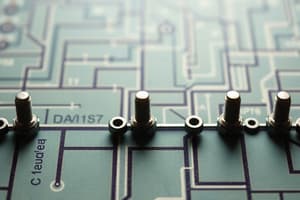Podcast
Questions and Answers
Explain the superposition theorem in simple terms.
Explain the superposition theorem in simple terms.
The superposition theorem states that in a linear circuit with multiple sources, the total current or voltage at any point is the algebraic sum of the currents or voltages produced by each source acting alone.
What is the significance of the superposition theorem in circuit analysis?
What is the significance of the superposition theorem in circuit analysis?
The superposition theorem simplifies the analysis of complex circuits by allowing us to consider the effects of each source separately and then combine them to find the total response of the circuit.
How is the superposition theorem applied in practical circuit analysis?
How is the superposition theorem applied in practical circuit analysis?
In practical circuit analysis, the superposition theorem is applied by deactivating one independent source at a time and calculating the response due to each individual source. The final response is then obtained by summing the effects of each individual source.
Flashcards are hidden until you start studying
Study Notes
Superposition Theorem
- The superposition theorem states that in a linear circuit, the total response (voltage or current) at any point is the algebraic sum of the responses that would be obtained if each source were acting alone.
- The theorem allows us to analyze complex circuits by breaking them down into simpler components and then combining the results.
Significance in Circuit Analysis
- The superposition theorem simplifies the analysis of circuits with multiple sources by enabling us to consider each source separately and then combine the effects.
- It is particularly useful in circuits where the sources are not in series or parallel, making it difficult to apply other circuit analysis techniques.
- The theorem helps to reduce the complexity of the circuit, making it easier to understand and analyze.
Application in Practical Circuit Analysis
- To apply the superposition theorem, each source is considered separately, and the response (voltage or current) at the desired point is calculated.
- The responses are then added algebraically to obtain the total response at that point.
- The theorem is commonly used in filter circuits, amplifier circuits, and other electronic circuits where multiple sources are present.
- It is also used in the analysis of three-phase circuits and other polyphase systems.
Studying That Suits You
Use AI to generate personalized quizzes and flashcards to suit your learning preferences.




